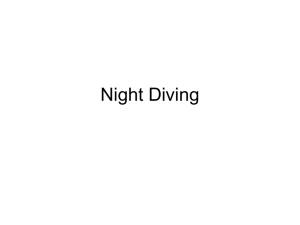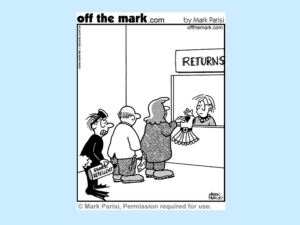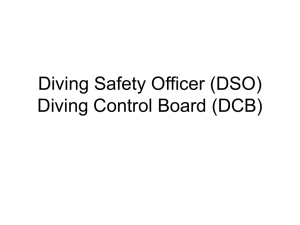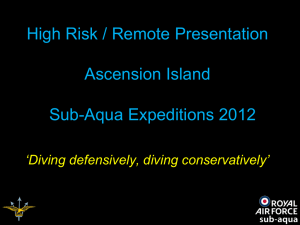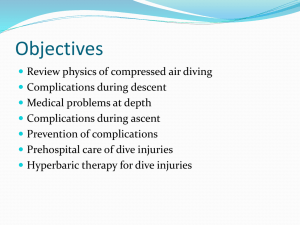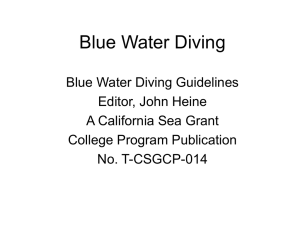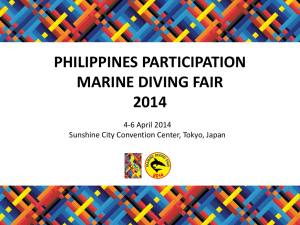form 14: risk control and hazard identification for boating and diving
advertisement
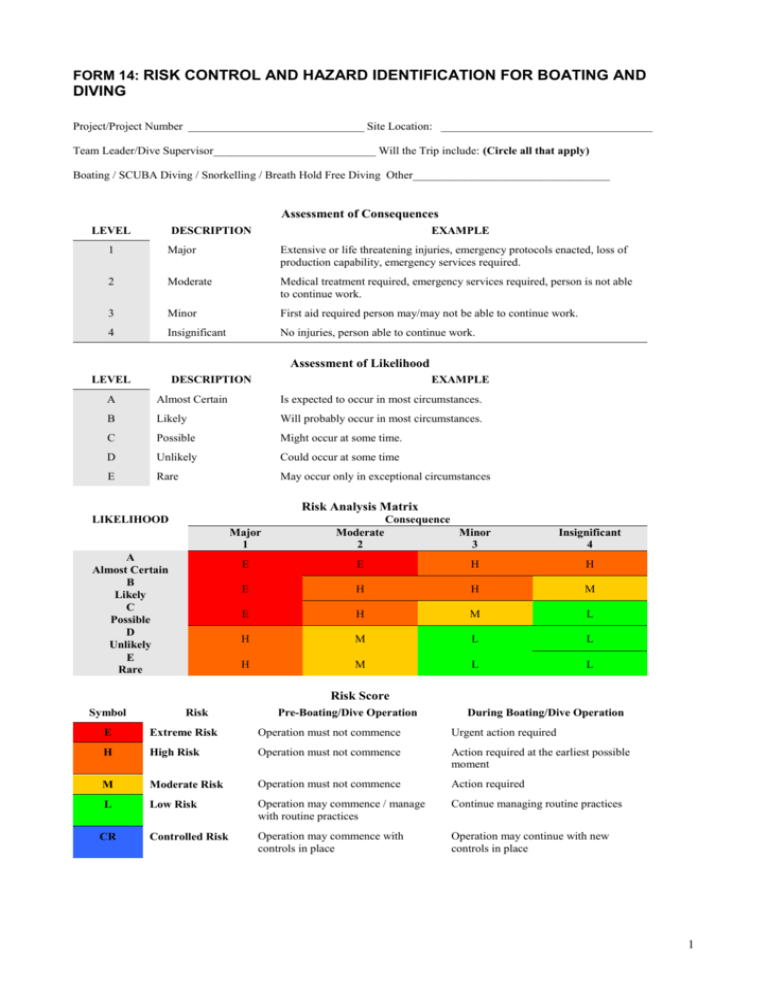
FORM 14: RISK CONTROL AND HAZARD IDENTIFICATION FOR BOATING AND DIVING Project/Project Number ______________________________ Site Location: ____________________________________ Team Leader/Dive Supervisor____________________________ Will the Trip include: (Circle all that apply) Boating / SCUBA Diving / Snorkelling / Breath Hold Free Diving Other__________________________________ Assessment of Consequences LEVEL DESCRIPTION EXAMPLE 1 Major Extensive or life threatening injuries, emergency protocols enacted, loss of production capability, emergency services required. 2 Moderate Medical treatment required, emergency services required, person is not able to continue work. 3 Minor First aid required person may/may not be able to continue work. 4 Insignificant No injuries, person able to continue work. Assessment of Likelihood LEVEL DESCRIPTION EXAMPLE A Almost Certain Is expected to occur in most circumstances. B Likely Will probably occur in most circumstances. C Possible Might occur at some time. D Unlikely Could occur at some time E Rare May occur only in exceptional circumstances Risk Analysis Matrix LIKELIHOOD Consequence A Almost Certain B Likely C Possible D Unlikely E Rare Major 1 Moderate 2 Minor 3 Insignificant 4 E E H H E H H M E H M L H M L L H M L L Risk Score Symbol Risk Pre-Boating/Dive Operation During Boating/Dive Operation E Extreme Risk Operation must not commence Urgent action required H High Risk Operation must not commence Action required at the earliest possible moment M Moderate Risk Operation must not commence Action required L Low Risk Operation may commence / manage with routine practices Continue managing routine practices Controlled Risk Operation may commence with controls in place Operation may continue with new controls in place CR 1 THIS DOCUMENT SHALL BE REVIEWED ON SITE AND THE DIVE PARTICIPANTS SHALL ACKNOWLEDGE THEIR UNDERSTANDING OF THE RISKS OF THE DIVE OPERATION BY SIGNING BELOW. Date Name Signature What you should do: 1. 2. 3. 4. 5. 6. • • • • • List in the following table** the HAZARDS you have identified that are associated with the field activities. Briefly describe in the table the risks associated with each hazard. Using the risk assessment chart assess, and record in the table the risk presented by the hazard (HIGH, MEDIUM, LOW). Address risks with a HIGH rating first. In the table indicate what control measures are being taken to minimise the risk. Fill out the table for each study site that has dramatically different hazards or specific hazards for a certain site Control Measures ELIMINATE the hazard. SUBSTITUTE something with a lesser risk, eg manual handling -substitute a smaller container. ISOLATE the hazard eg proper storage of chemicals or firearm. Use ADMINISTRATIVE CONTROLS -provide training, adequate supervision. Provide PERSONAL PROTECTIVE EQUIPMENT eg gloves, safety boots, sunhat, sunscreen. Controls should be selected from as high up on the list as reasonably practical to maximise effectiveness. In many cases a combination of controls may be necessary to reduce the hazard. 2 Hazard Identification for Project Description of hazard Description of risk Assessed Consequence Assessed Likelihood Assessed Risk Risk Control Measures Implemented Assessed Risk After Control 3 Biological Hazard Identification Description of hazard Description of risk Assessed Consequence Assessed Likelihood Assessed Risk Risk Control Measures Implemented Assessed Risk After Control Irukandji and box jellyfish sting Operational activities in tropical seas (between November and May) 1 D High wear full body protection and hoods, have 2 l vinegar, first aid kit and provider, briefed on hazard. Higher risk areas require implementation of JCU Cubozoan Protocol. CR Other coelenterates Stings from physalia, other jellyfish or ctenophores 3 D Low Risk As above CR Shark attack (nonattractant) Abrasion or bit injury 1 D High Maintain lookout for aggressive sharks, do not enter water if one is seen, exit water if one is seen during dive, first aid kit and provider, Shark Shield recommended CR Shark attack (attractant), [spearfishing?] Abrasion or bit by more determined shark 1 C Extreme Limit attractant in water (bag speared or caught fish), experienced spearfishers or netters, trained personnel on site, as above, Shark Shields recommended CR Crocodile attack Bit and or crush injury 1 D Moderate Gather recent information about crocodile sightings in the area, no diving for one week post most recent sighting, survey area before entering the water, maintain lookout during operation, divers to remain close to dive vessel, exit water on sighting during dive. Do not return to same dive site regularly, alternate sites and they adopt to consistent routines CR Fish spine envenomations Toxic and or infectious reaction 3 C Moderate Maintain neutral buoyancy and avoid contact with substratum, wear gloves were contact is unavoidable, covered footwear used for transiting shallows, briefed on possible species CR Other fish and invertebrates bites Laceration, toxic or infectious reaction 3 C Moderate As above CR Cuts and stings Laceration, or infectious reaction Toxic and infectious reaction 3 C Moderate As above, treat even minor injuries as soon as possible after incident CR 3 D Low Risk Crown of Thorns Maintain neutral buoyancy and avoid contact with substratum, wear gloves were contact is unavoidable, covered footwear used for transiting shallows, briefed on possible species Other Other Other 4 Operational Hazard Identification Description of hazard Description of risk Assessed Consequence Assessed Likelihood Assessed Risk Risk Control Measures Implemented Assessed Risk After Control manual handling lifting field gear back strain/sprain 2 C High pack gear into easily lifted containers, team lift heavy items, revise correct lifting technique CR Boat handling Loss of control of boat causing accident 3 C Moderate CR Site entry/exit Accident causing harm 3 C Moderate Navigation Getting lost 3 C Moderate Only experienced/qualified personnel to operate vessel, operator briefed and familiarised with vessel Anchor vessel in suitable depth of water, advise personnel as to the best entry and exit points and techniques, use appropriate devices to assist with locating and using entry and exit points Have and use GPS and charts, local knowledge, brief personnel on hazards and operation of navigation equipment Equipment deployment and recovery Damage to personnel (back strain/sprain), or vessel 3 C Moderate Use equipment suitable for deployment and/or recovery from vessel, modify or rig vessel to handle difficult equipment, have sufficient personnel to handle equipment, use proper lifting techniques CR Sun exposure Skin damage, affected performance 3 C Moderate Wear sun protective clothing and sunscreen, brief personnel on hazards CR Dehydration Affected performance, increased risk illness 2 D High Provide and consume adequate water and non-alcohol beverages and brief personnel on hazard CR Medical emergency Injury, illness or Death 1 C Extreme Trained first aider and kit on site, communication equipment (VHF, mobile phone) CR Fuel vapour explosion/Fire Damage, burn or loss of vessel or personnel 1 E High Fuel stored in designated areas with adequate ventilation, no smoking or naked flames on board, limit vapour and tank pressure build-up CR Collision Damage or loss of vessel or personnel 3 C Moderate Operate vessel in accordance with navigational guidelines, keep constant watch of other vessels in the area, VHF and warning signals used when vessel approach to close CR Grounding Damage or loss of vessel or personnel 4 D Low Low Motor breakdown Stranding at sea 4 D Low Slow speed in and around reefs and other underwater obstructions, use GPS and Navigational charts Regular servicing of vessel motor/s, checks carried out before trip, authorised officer nominated for alerting of non-return of boating party, communication equipment on board with personnel briefed on its use. Login and logout with port and/or Volunteer Sea Rescue group. CR CR Low Other Other 5 Diving Related Hazard Identification Description of hazard Description of risk Breath hold diving Shallow water blackout SCUBA diving Operating in non breathable environment Repetitive dives Increased chance of DCI Multi-day diving Increased chance of DCI Dive depth Increased chance of DCI Dive duration Increased chance of DCI More than one ascent/dive Increased chance of DCI Ascent rate Increased chance of DCI High exertion predive Increased chance of DCI High exertion during dive Increased chance of DCI High exertion post-dive Increased chance of DCI Strong currents Fatigue and inability to remain within operational area Running into obstructions and loss of buddy contact Low visibility Assessed Consequence Assessed Likelihood Assessed Risk Risk Control Measures Implemented 1 D High 1 D High 1 D High 1 D High 1 D High Schedule rest days (if 3 or more low stress dives per day on 3 consecutive days or for lower frequency higher intensity dives then a rest day is taken on day 4), depth and bottom times are minimised for task, as for scuba diving Dives are planned with contingencies, safety stops used where required, constantly monitor depth throughout dive, as per scuba diving 1 D High Dives are planned with contingencies, safety stops used where required, constantly monitor dive time throughout dive, as per scuba diving Cr 1 D High Dives planned to avoid more than one ascent per dive, dive profiles monitored to avoid saw tooth or excessive changes in depth other than ascent at end of dive, as for scuba diving CR 1 D High Gauges to be monitored, slow ascent rate to be used, ascent line or topography used where appropriate, safety stop to be used where required, as for scuba diving CR 1 D High 1 D High 1 D High 4 C Low 4 C Low Brief personnel on hazards, operate in buddy pairs one up one down, 60 second breath hold dive time, Trained personnel, dive briefed on hazards, planned dive, underwater life support equipment checked for faults before dive, buddy or tethered diver system used, fit divers only, signals and lost buddy contact procedure reviewed, safe diving practices followed, DCIEM tables used, oxygen and first aid kits on site, dive flag used Allow sufficient surface intervals between dives, avoid reverse profile repetitive dives, dives planned to DCIEM and AS2299 guidelines, as for scuba diving Avoid activities that require high exertion prior to dive, plan dive operation around environmental conditions (tides/reef flat cartage), use dedicated boat persons or persons least at risk for unavoidable high exertion work For activities involving high exertion reduce dive time and/or depth, plan dive operation to minimise number of high exertion dives/day and the number of consecutive days requiring increased intensity, as for scuba diving Avoid activities that require high exertion post dive, plan dive operation around environmental conditions (tides/reef flat cartage), use dedicated boat persons or persons least at risk for unavoidable high exertion work Dive starts into current, constant lookout established, surface buoy, safety sausage and whistle to be carried for dives greater than 150m from vessel, monitor air consumption and fatigue throughout dive, surface support vessel available, as for scuba diving Stay in close proximity to buddy, consider tethered diving, review lost diver procedure, as for scuba diving Assessed Risk After Control CR CR CR CR CR CR CR CR Low Low 6 Description of hazard Description of risk Night dive Loss of light inability to communicate with attendant Locating divers at surface Drifting away from site or rescue Contact with substrate causing injury Surf or swell Assessed Consequence Assessed Likelihood Assessed Risk Risk Control Measures Implemented 1 D High 3 D Low 3 C Moderate 1 E High Survey waves before entering water, cancel dive if considered dangerous, only experienced divers to operate in high energy habitats, reassess wave energy constantly throughout dive, recall system in place, brief divers. Divers to carry knife, particularly when working with ropes and lines, no entering overhead environments. 1 D High Fills from reputable filling stations, regular air tests carried out, air to be checked prior to diving for unusual smells or taste, dives terminated if underwater maladies occur 1 D High Normal scuba diving procedures with 2 dive attendants, minimum for each diver of 1 dive light + backup, entry and exit points marked, surface support has suitable search light, familiarity with dive site, site marked for underwater operations All personnel briefed on dive time, depths and site area, lookout in place, signalling devices to be carried by divers when operating further than 150m from vessel Assessed Risk After Control CR Low CR Entrapment Inability to reach surface Breathing air contamination Gas toxicity Out of air emergency Lack of breathing medium Use of unfamiliar equipment Malfunction causing distress or emergency 3 C Moderate All personnel to frequent themselves or be inducted to the use of any unfamiliar equipment prior to use in the field CR Equipment malfunction Inability to support life or safely conduct task, 3 D low Gear serviced routinely, equipment tested before use faulty equipment not to be used, faults occurring during operation to lead to termination CR Dehydration Increased chance DCI or properly function 2 C High Provide ample non alcoholic beverages water on site inform personnel of fluid intake requirements CR Medical emergency Personnel suffer illness or injury 1 E High Diver fitness for dive Increased chance DCI or inability to rescue 3 D Low Marine traffic Collision with divers 1 E High Mixed Gas Diving (Nitrox) Increased chance DCI, Oxygen toxicity 1 D High Stay within the DSAT and DCIEM No decompression tables for repetitive diving, do not exceed depth restrictions, perform safety stops, use an Nitrox dive computer. Only trained and qualified diver can participate. Semi-Closed Diving Increased chance DCI, 1 D High Stay within the DSAT and DCIEM No Decompression tables for repetitive diving and calculated EAD for dive plans, do not exceed depth restrictions, perform safety stops, Divers to monitor gauges regularly, review signals, follow safe diving practices Safe practices followed qualified first aider on site All divers to possess a current AS 2299 dive medical, only fit divers participate in operation, question divers on how they are feeling any concerns replace diver and follow-up concerns, Keep proper watch for boats and divers. Use dive flag to indicate diving operation underway, use surface support personnel, use marine radio to communicate with other vessels CR CR CR CR Low CR CR Low 7 (Rebreather) Oxygen toxicity maintain scrubbers and filters in equipment. Only trained divers can participate. Other Hazards Description of hazard Missing diver Description of risk Drifting and/or injured diver Assessed Consequence Assessed Likelihood Assessed Risk 1 E High Risk Control Measures Implemented Close buddy contact, buddy separation procedures reviewed, lookout stationed, divers signed in and out of water, trained personnel Assessed Risk After Control CR 8
